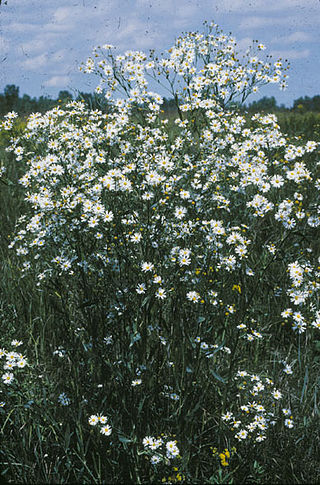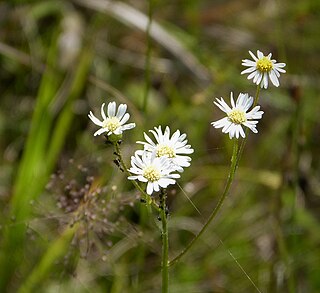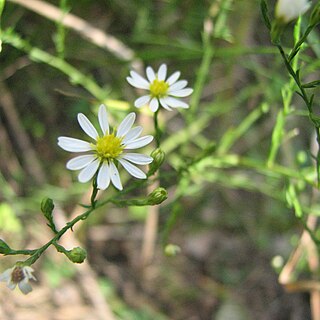
Helianthus is a genus comprising about 70 species of annual and perennial flowering plants in the daisy family Asteraceae commonly known as sunflowers. Except for three South American species, the species of Helianthus are native to North America and Central America. The best-known species is the common sunflower. This and other species, notably Jerusalem artichoke, are cultivated in temperate regions and some tropical regions, as food crops for humans, cattle, and poultry, and as ornamental plants. The species H. annuus typically grows during the summer and into early fall, with the peak growth season being mid-summer.

Bellis perennis, the daisy, is a European species of the family Asteraceae, often considered the archetypal species of the name daisy. To distinguish this species from other plants known as daisies, it is sometimes qualified as common daisy, lawn daisy or English daisy.

Boltonia asteroides, the white doll's daisy, false chamomile, or false aster, is a species of plant native to the United States and Canada. It is found primarily in the Mississippi Valley and Great Plains from Saskatchewan south to Texas and Florida, with isolated populations in the eastern United States. Reports of the species in New England, New York, and the Pacific Northwest appear to be introductions.

Boltonia diffusa, the smallhead doll's daisy, is a North American species of plants in the family Asteraceae. It native to the United States, primarily the states along the Gulf of Mexico from Texas to Florida plus the lower Mississippi Valley from Louisiana to Illinois. There additional populations in the eastern United States as far north as Virginia.

Symphyotrichum laeve is a flowering plant native to Canada, the United States, and Coahuila (Mexico). It has the common names of smooth blue aster, smooth aster, smooth-leaved aster, glaucous Michaelmas-daisy and glaucous aster.

Boltonia is a genus of plants in the family Asteraceae native primarily to North America with one species in eastern Asia.

Erigeron annuus, the annual fleabane, daisy fleabane, or eastern daisy fleabane, is a species of herbaceous, annual or biennial flowering plant in the family Asteraceae.

Symphyotrichum ascendens is a species of flowering plant in the family Asteraceae known by the common names western aster, long-leaved aster, and Rocky Mountain aster. Blooming July–September, it is native to western North America and can be found at elevations of 500–3,200 m (1,600–10,500 ft) in several habitats.

Enceliopsis covillei, known by the common name Panamint daisy, is a rare North American desert species of flowering plant in the family Asteraceae.

Symphyotrichum pilosum is a perennial, herbaceous, flowering plant in the Asteraceae family native to central and eastern North America. It is commonly called hairy white oldfield aster, frost aster, white heath aster, heath aster, hairy aster, common old field aster, old field aster, or steelweed. It may reach 20 to 120 centimeters tall, and its flowers have white ray florets and yellow disk florets.

Carex pensylvanica is a species of flowering plant in the sedge family commonly called Pennsylvania sedge. Other common names include early sedge, common oak sedge, and yellow sedge.

Symphyotrichum depauperatum, commonly known as serpentine aster or starved aster, is a rare species in the family Asteraceae adapted to serpentine barrens, an ecosystem with a high concentration of toxic metals in the soil. It has been found in Pennsylvania, Maryland, and on some diabase glades in North Carolina. It grows to 50 centimeters and has white ray florets surrounding a center of yellow disk florets.
Townsendia leptotes is a species of flowering plant in the family Asteraceae known by the common names common Townsend daisy and slender townsendia. It is native to the western United States, where it grows in the alpine climates of high mountain ranges from California to Montana to New Mexico.

Boltonia decurrens is a rare species of flowering plant in the family Asteraceae known by the common names decurrent false aster and claspingleaf doll's daisy. It is native to the floodplains along the Illinois and Mississippi Rivers in the United States, where the habitat has been drastically altered, leading to its decline. The plant was once distributed across 400 kilometers of riverside forest from LaSalle, Illinois, to St. Louis, Missouri. As the rivers and riparian habitat alongside them have been developed, the plant's distribution has been fragmented into about 20 separate populations, mostly in Illinois. At one point it was thought to have been extirpated from Missouri, but a few populations have been located near St. Louis since the mid-1980s. Despite having declined over time, several populations of the plant contain many thousands of individuals. Populations vary depending on the amount and duration of flooding that occurs in the area each year. The plant is a federally listed threatened species.

Astranthium integrifolium, the entireleaf western daisy or eastern western-daisy, is a North American species of flowering plants in the family Asteraceae. It is native to the east-central part of the United States primarily the Cumberland Plateau and Ohio/Tennessee Valley. It is found in the States of Tennessee, Kentucky, Alabama, and Georgia, with isolated populations in Mississippi and West Virginia.
Boltonia apalachicolensis, common name Apalachicola doll's-daisy, is a North American species of plants in the family Asteraceae. It is found in the "panhandle" region of northwestern Florida, and has been found in south Louisiana, and Mississippi in the United States.
Boltonia caroliniana, common name Carolina doll's-daisy, is a North American species of plants in the family Asteraceae. It is found only in the southeastern United States, primarily in the states of North Carolina, South Carolina, and Virginia with a few isolated populations in western Georgia.
Erigeron bellidiastrum, the western daisy fleabane or sand fleabane, is a species of fleabane in the family Asteraceae. It is native to northern Mexico and the western and central United States.

Symphyotrichum jessicae is a species of flowering plant in the family Asteraceae endemic to Idaho and Washington states in the United States. Commonly known as Jessica's aster, it is a perennial, herbaceous plant that may reach 40 to 150 centimeters tall. Its flowers have violet ray florets and yellow disk florets. It is of conservation concern and known only from the Palouse River and Clearwater River drainages of eastern Washington and northwestern Idaho.

Symphyotrichum retroflexum is a species of flowering plant in the family Asteraceae native to the southeastern United States. Commonly known as rigid whitetop aster, it is a perennial, herbaceous plant that may reach 40 to 100 centimeters tall. Its flowers have blue to purple ray florets and cream to pale yellow then pinkish disk florets. It is known only from the Blue Ridge Mountains in Alabama, Georgia, North Carolina, South Carolina, Tennessee, and Virginia, where it grows in wooded areas at elevations of 400–1,500 meters. As of September 2021, NatureServe classified it as Apparently Secure (G4); it had been reviewed last in 1994 and is marked as "needs review". There is an introduced presence of S. retroflexum in southeast China.














